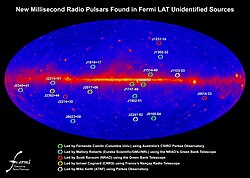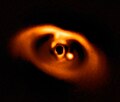Overview
A super-Earth is an extrasolar planet with a mass between that of Earth and the Solar System's gas giants. The term super-Earth refers only to the mass of the planet and does not imply anything about the surface conditions or habitability. [7]
Andrew Howard of the University of California at Berkeley, announced the planet's discovery at the 215th meeting of the American Astronomical Society in Washington, D.C.
At the meeting, the details of the findings were first presented by the research group which had used the twin Keck Telescopes in Hawaii to detect the exoplanet. With the twin telescopes functioning as a single observatory, by means of interferometry, it was determined that HD156668b is only four times larger than the Earth, and the second smallest exoplanet yet found. [6]
There are over 400 exoplanets thus far discovered, and only a very small number are categorized as Super-Earth class. Finding such planets as HD156668b, which are closer to Earth in size, has become a priority in Astronomy science. For example, the Kepler mission, is part of the intense popular interest surrounding the discovery of hundreds of planets orbiting other stars. Kepler telescope, however has a more specific mission - to discover hundreds of terrestrial planets which are defined as exoplanets that are one half to twice the size of the Earth. [6] [8]
A priority is to find those in the habitable zone of their stars where liquid water and possibly life might exist. Discoveries such as HD156668b allow astronomers such as the Keck research group to demonstrate they are able to find smaller and smaller planets. Ultimately, results such as those from the Keck group, and the Keppler mission will allow the Solar System to be placed within a continuum of planetary systems in the Galaxy. [6] [8]
HD156668b, is considered to be relatively close at just 80 light-years away. It is in the constellation Hercules. According to early measurements, it appears to be orbiting its parent star about once every four days (approximately). The wobble of the planet's star revealed the existence of HD156668b. The alignment probability is 0.5% for finding a planet in an Earth-like orbit about a solar-like star, compared to the giant planets discovered in four-day orbits, the alignment probability is more like 10%. [6] [8]
Other researchers from the California Institute of Technology, Yale University and Penn State University also participated in the study. [9]







